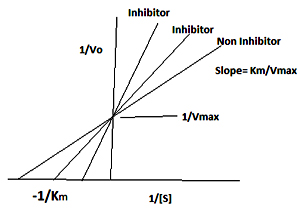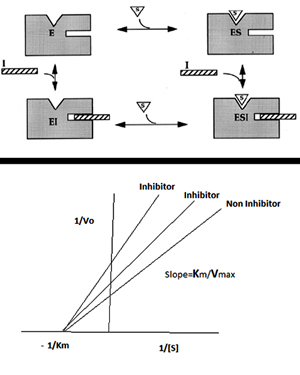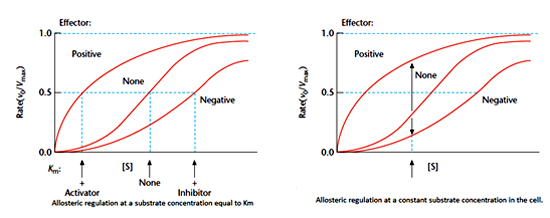Inhibition of Enzymes
Sakshi Education

Certain chemical compounds negatively affect the ability of an enzyme to catalyse a reaction and thereby inhibit its activity. Such compounds are termed as Inhibitors. Based on the effect of dialysis on inhibition, there are two major types of inhibitors: Irreversible and Reversible inhibitors.
Inhibitors which bind to the enzyme covalently, destroying its functional group necessary for its catalytic activity in an irreversible manner are termed as Irreversible inhibitors.
Inhibitors which bind to the enzyme covalently, destroying its functional group necessary for its catalytic activity in an irreversible manner are termed as Irreversible inhibitors.
- D- IsopropyI fluoro phosphate (DFP) inhibits the activity of serine proteases like trypsin, chymotrypsin, cocoonase, etc. DFP also inhibits the enzyme Acetylcholinesterase by hydrolyzing the Acetyl choline molecules secreted during nerve cell synapse into acetate and choline before the next synapse occurs. DFP is used in malathion and other insecticides, as it can be degraded by higher animals & not by insects.
- Iodoacetate irreversibly inhibits the activity of thiolproteases.
- TPCK (Tosyl phenyl alanine cholromethyl ketone) specifically inhibits the activity of chymotrypsin.
Reversible inhibition:
This type of inhibition is caused by the binding of inhibitors to the enzyme noncovalently and therefore can be eliminated by dialysis or simple dilution.
Reversible inhibitors are classified into two classes
a) Competitive inhibitors, and
b) Non competitive inhibitors
Competitive inhibitors:
If an inhibitor binds to the active site of an enzyme to form a dead end complex, preventing the substrate molecule from binding. It is a competitive inhibitor. Competitive inhibition refers to the case of the inhibitor binding exclusively to the free enzyme and not at all to the ES binary complex. The type of inhibition in which the substrate and the inhibitor compete for a common enzyme species, is termed as Competitive Inhibition.
The binding is due to electrostatic attraction or hydrophobic interactions as a result it is reversed by usually enhancing the substrate concentration.
k1 [E] + [I] [EI] k2 The EI complex so formed however is not transformed to a product.
The effectiveness of an inhibitor is given by its inhibition constant k1, which is a measure of the enzyme’s affinity for a specific inhibitor molecule since k1 = [E] [I] / [EI] A very low k1 indicates poor binding of the inhibitor to the enzyme.
Competitive inhibitor is easily recognized by determining the effect of inhibitor concentration on the relationship between substrate concentration and initial rate where the double reciprocal plot is as shown below.
 In presence of competitive inhibitor, the Vmax value remains constant but the Km increases. As Km increases, this inhibition can be released by increasing substrate concentration.
In presence of competitive inhibitor, the Vmax value remains constant but the Km increases. As Km increases, this inhibition can be released by increasing substrate concentration.
Eg: Succinate dehydrogenase (SDH) is inhibited by malonate anion which resembles succinate in having two ionized carboxyl groups but has only three C-atoms. It is not dehydrogenated by SDH; it blocks the active site. Increasing succinate concentration decreases the inhibition by malonate. Oxaloacetate also inhibits SDH due to its structural relationship (Distance between the two anionic groups).
The effectiveness of different allosteric inhibitors may be determined by comparing their k1 values.
Noncompetitive Inhibitor:
 Noncompetitive inhibition refers to the case in which an inhibitor displays binding affinity for both the free enzyme and the enzyme—substrate binary complex.Inhibitor can bind either directly to the free enzyme or the enzyme-substrate complex to yield either the enzyme-substrate [ES] complex or enzyme-substrate-inhibitor [ESI] complex. The non competitive inhibitor is named so as it does not compete with the substrate for the active site, instead it binds to a new site which is available both in free enzyme and enzyme substrate complex. So this type of inhibition cannot be reversed by increasing the substrate concentration.
Noncompetitive inhibition refers to the case in which an inhibitor displays binding affinity for both the free enzyme and the enzyme—substrate binary complex.Inhibitor can bind either directly to the free enzyme or the enzyme-substrate complex to yield either the enzyme-substrate [ES] complex or enzyme-substrate-inhibitor [ESI] complex. The non competitive inhibitor is named so as it does not compete with the substrate for the active site, instead it binds to a new site which is available both in free enzyme and enzyme substrate complex. So this type of inhibition cannot be reversed by increasing the substrate concentration.
In the presence of non competitive inhibitor, the Vmax value gets altered but the Km value remains unchanged. Inhibition of Chymotrypsin by H+ or low pH exhibits this kind of inhibition.
Uncompetitive Inhibition:
 Uncompetitive inhibitors bind exclusively to the ES complex, rather than to the free enzyme form to yield enzyme substrate inhibitor [ESI] complex. The free enzyme does not contain any inhibitory site but the binding of substrate to the enzyme induces conformational changes resulting in the exposure of inhibitory site, to which the inhibitor binds.
Uncompetitive inhibitors bind exclusively to the ES complex, rather than to the free enzyme form to yield enzyme substrate inhibitor [ESI] complex. The free enzyme does not contain any inhibitory site but the binding of substrate to the enzyme induces conformational changes resulting in the exposure of inhibitory site, to which the inhibitor binds.
The apparent effect of an uncompetitive inhibitor is to decrease Vmax and to actually decrease Km (i.e., increase the affinity of the enzyme for its substrate). This type of inhibition is a rare phenonmenon. Inhibition of Aryl sulphotase by hydrazine exhibits such kind of inhibition.
Partial Inhibition:
Some of the reversible inhibitors may cause partial inhibition with slow production of products. An enzyme with the inhibitor bound can still turn over the reactants into products, albeit at a far reduced rate compared to the uninhibited enzyme. Such situations manifest partial inhibition. The distinguishing feature of a partial inhibitor is that the activity of the enzyme cannot be driven to zero even at very high concentrations of the inhibitor.
Mixed type Inhibition:
Some inhibitors show mixed inhibition which is intermediate between competitive and non-competitive and some others show mixed inhibition between non-competitive and uncompetitive inhibition.
Allosteric Enzymes and inhibition:
Enzyme which possess a modulator site or allosteric site apart from the active site are called Allosteric enzymes. In general the allosteric enzyme molecules are larger and more complex than the simple enzyme having two or more polypeptide chains or subunits. Mostly these enzymes are oligomeric and contain more than one ligand binding site. Almost all the regulatory enzymes are allosteric enzymes. Modulators or effectors bind to allosteric site and thereby cause conformational changes to alter the enzymatic activity. Modulators are of types-positive and negative.
In metabolic pathways involving reactions catalyzed by multi enzyme system, the first enzyme in the pathway acts as the key point of regulation. Whenever the end product of a metabolic sequence increases above normal level, it acts as an inhibitor of the regulatory enzyme thus establishing Feedback inhibition. The end product does not bind to the substrate site, but to the allosteric site. When the concentration of the modulator in the cell increases, the binding of this negative modulator/inhibitor turns off the allosteric enzyme and it is turned on when the modulator leaves the enzyme, whenever its level in the cell decreases.
On the other hand, positive modulators act as activators and stimulate the enzyme to function. These mainly consist substrate molecule itself but unlike negative modulators are not the end product of the enzymatic sequence.
Stimulation of allosteric enzymes upon binding to a substrate is called as ‘homotropic’ (Since the substrate and modulator are identical), and they have two or more binding sites for the substrate. While the enzymes which are inhibited by their modulator are called ‘heterotropic’ enzymes. Allosteric enzymes exhibit differential behaviour when compared to the classical Michaelis Menten behaviour based on the inhibitor being an inhibitor or stimulator.
They do show saturation with the substrate when the latter is added in high enough concentration but when the initial rate is plotted against the substrate concentration, a sigmoid saturation curve is obtained instead of classical hyperbola shown by a non regulatory enzyme. Due to this the point at which half of the maximum velocity is reached cannot be referred to as Km but referred as [S]0.5 or K0.5.
 A homotropic allosteric enzyme has multiple binding sites for its substrate and they act cooperatively, which accounts for the sigmoid increase in the rate of enzymatic activity, On increasing the substrate concentration with the heterotropic enzyme, where the modulator is some metabolite other than the substrate the shape of the saturation curve cannot be generalised and depends on whether it is a simulatory or inhibitory type of a modulator.
A homotropic allosteric enzyme has multiple binding sites for its substrate and they act cooperatively, which accounts for the sigmoid increase in the rate of enzymatic activity, On increasing the substrate concentration with the heterotropic enzyme, where the modulator is some metabolite other than the substrate the shape of the saturation curve cannot be generalised and depends on whether it is a simulatory or inhibitory type of a modulator.
If the modulator is inhibitory, the substrate curve may become more sigmoid with an increase in K0.5. If the modulatory is stimulatory, it may cause the curve to become hearly hyperbolic with a decrease in K0.5 but not in Vmax.
This type of inhibition is caused by the binding of inhibitors to the enzyme noncovalently and therefore can be eliminated by dialysis or simple dilution.
Reversible inhibitors are classified into two classes
a) Competitive inhibitors, and
b) Non competitive inhibitors
Competitive inhibitors:
If an inhibitor binds to the active site of an enzyme to form a dead end complex, preventing the substrate molecule from binding. It is a competitive inhibitor. Competitive inhibition refers to the case of the inhibitor binding exclusively to the free enzyme and not at all to the ES binary complex. The type of inhibition in which the substrate and the inhibitor compete for a common enzyme species, is termed as Competitive Inhibition.
The binding is due to electrostatic attraction or hydrophobic interactions as a result it is reversed by usually enhancing the substrate concentration.
k1 [E] + [I] [EI] k2 The EI complex so formed however is not transformed to a product.
The effectiveness of an inhibitor is given by its inhibition constant k1, which is a measure of the enzyme’s affinity for a specific inhibitor molecule since k1 = [E] [I] / [EI] A very low k1 indicates poor binding of the inhibitor to the enzyme.
Competitive inhibitor is easily recognized by determining the effect of inhibitor concentration on the relationship between substrate concentration and initial rate where the double reciprocal plot is as shown below.
 In presence of competitive inhibitor, the Vmax value remains constant but the Km increases. As Km increases, this inhibition can be released by increasing substrate concentration.
In presence of competitive inhibitor, the Vmax value remains constant but the Km increases. As Km increases, this inhibition can be released by increasing substrate concentration. Eg: Succinate dehydrogenase (SDH) is inhibited by malonate anion which resembles succinate in having two ionized carboxyl groups but has only three C-atoms. It is not dehydrogenated by SDH; it blocks the active site. Increasing succinate concentration decreases the inhibition by malonate. Oxaloacetate also inhibits SDH due to its structural relationship (Distance between the two anionic groups).
The effectiveness of different allosteric inhibitors may be determined by comparing their k1 values.
Noncompetitive Inhibitor:
 Noncompetitive inhibition refers to the case in which an inhibitor displays binding affinity for both the free enzyme and the enzyme—substrate binary complex.Inhibitor can bind either directly to the free enzyme or the enzyme-substrate complex to yield either the enzyme-substrate [ES] complex or enzyme-substrate-inhibitor [ESI] complex. The non competitive inhibitor is named so as it does not compete with the substrate for the active site, instead it binds to a new site which is available both in free enzyme and enzyme substrate complex. So this type of inhibition cannot be reversed by increasing the substrate concentration.
Noncompetitive inhibition refers to the case in which an inhibitor displays binding affinity for both the free enzyme and the enzyme—substrate binary complex.Inhibitor can bind either directly to the free enzyme or the enzyme-substrate complex to yield either the enzyme-substrate [ES] complex or enzyme-substrate-inhibitor [ESI] complex. The non competitive inhibitor is named so as it does not compete with the substrate for the active site, instead it binds to a new site which is available both in free enzyme and enzyme substrate complex. So this type of inhibition cannot be reversed by increasing the substrate concentration. In the presence of non competitive inhibitor, the Vmax value gets altered but the Km value remains unchanged. Inhibition of Chymotrypsin by H+ or low pH exhibits this kind of inhibition.
Uncompetitive Inhibition:
 Uncompetitive inhibitors bind exclusively to the ES complex, rather than to the free enzyme form to yield enzyme substrate inhibitor [ESI] complex. The free enzyme does not contain any inhibitory site but the binding of substrate to the enzyme induces conformational changes resulting in the exposure of inhibitory site, to which the inhibitor binds.
Uncompetitive inhibitors bind exclusively to the ES complex, rather than to the free enzyme form to yield enzyme substrate inhibitor [ESI] complex. The free enzyme does not contain any inhibitory site but the binding of substrate to the enzyme induces conformational changes resulting in the exposure of inhibitory site, to which the inhibitor binds.The apparent effect of an uncompetitive inhibitor is to decrease Vmax and to actually decrease Km (i.e., increase the affinity of the enzyme for its substrate). This type of inhibition is a rare phenonmenon. Inhibition of Aryl sulphotase by hydrazine exhibits such kind of inhibition.
Partial Inhibition:
Some of the reversible inhibitors may cause partial inhibition with slow production of products. An enzyme with the inhibitor bound can still turn over the reactants into products, albeit at a far reduced rate compared to the uninhibited enzyme. Such situations manifest partial inhibition. The distinguishing feature of a partial inhibitor is that the activity of the enzyme cannot be driven to zero even at very high concentrations of the inhibitor.
Mixed type Inhibition:
Some inhibitors show mixed inhibition which is intermediate between competitive and non-competitive and some others show mixed inhibition between non-competitive and uncompetitive inhibition.
Allosteric Enzymes and inhibition:
Enzyme which possess a modulator site or allosteric site apart from the active site are called Allosteric enzymes. In general the allosteric enzyme molecules are larger and more complex than the simple enzyme having two or more polypeptide chains or subunits. Mostly these enzymes are oligomeric and contain more than one ligand binding site. Almost all the regulatory enzymes are allosteric enzymes. Modulators or effectors bind to allosteric site and thereby cause conformational changes to alter the enzymatic activity. Modulators are of types-positive and negative.
In metabolic pathways involving reactions catalyzed by multi enzyme system, the first enzyme in the pathway acts as the key point of regulation. Whenever the end product of a metabolic sequence increases above normal level, it acts as an inhibitor of the regulatory enzyme thus establishing Feedback inhibition. The end product does not bind to the substrate site, but to the allosteric site. When the concentration of the modulator in the cell increases, the binding of this negative modulator/inhibitor turns off the allosteric enzyme and it is turned on when the modulator leaves the enzyme, whenever its level in the cell decreases.
On the other hand, positive modulators act as activators and stimulate the enzyme to function. These mainly consist substrate molecule itself but unlike negative modulators are not the end product of the enzymatic sequence.
Stimulation of allosteric enzymes upon binding to a substrate is called as ‘homotropic’ (Since the substrate and modulator are identical), and they have two or more binding sites for the substrate. While the enzymes which are inhibited by their modulator are called ‘heterotropic’ enzymes. Allosteric enzymes exhibit differential behaviour when compared to the classical Michaelis Menten behaviour based on the inhibitor being an inhibitor or stimulator.
They do show saturation with the substrate when the latter is added in high enough concentration but when the initial rate is plotted against the substrate concentration, a sigmoid saturation curve is obtained instead of classical hyperbola shown by a non regulatory enzyme. Due to this the point at which half of the maximum velocity is reached cannot be referred to as Km but referred as [S]0.5 or K0.5.
 A homotropic allosteric enzyme has multiple binding sites for its substrate and they act cooperatively, which accounts for the sigmoid increase in the rate of enzymatic activity, On increasing the substrate concentration with the heterotropic enzyme, where the modulator is some metabolite other than the substrate the shape of the saturation curve cannot be generalised and depends on whether it is a simulatory or inhibitory type of a modulator.
A homotropic allosteric enzyme has multiple binding sites for its substrate and they act cooperatively, which accounts for the sigmoid increase in the rate of enzymatic activity, On increasing the substrate concentration with the heterotropic enzyme, where the modulator is some metabolite other than the substrate the shape of the saturation curve cannot be generalised and depends on whether it is a simulatory or inhibitory type of a modulator.If the modulator is inhibitory, the substrate curve may become more sigmoid with an increase in K0.5. If the modulatory is stimulatory, it may cause the curve to become hearly hyperbolic with a decrease in K0.5 but not in Vmax.
Published date : 23 May 2014 03:06PM










